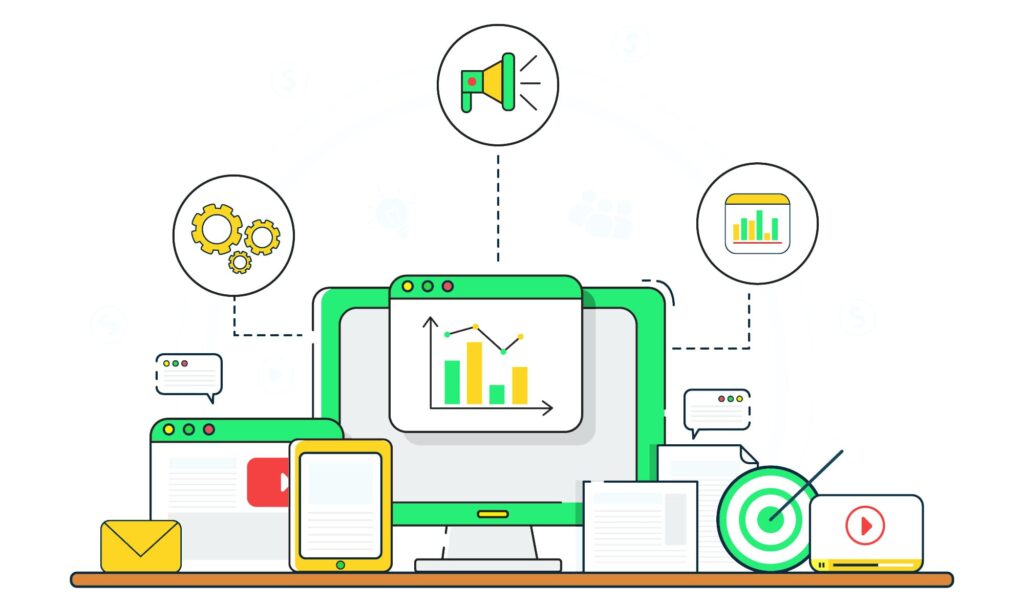In the ever-evolving digital landscape, establishing a meaningful connection with the audience requires a subtle approach.
Omnichannel marketing stands out as a potent strategy, enabling brands to seamlessly integrate their presence across various channels. This comprehensive guide explores the intricacies of the content ecosystem, offering practical insights into successfully navigating the complexities of omnichannel marketing.
Omnichannel Marketing Explained for Beginners
Imagine you’re planning a birthday surprise for your friend. You want everything to be perfect, from the decorations to the gift. Now, think of your friend as a customer, and your surprise preparations as various ways a business reaches out to them.
In the world of marketing, omnichannel is like throwing an amazing surprise party for your friend, but instead of one big surprise, it’s a coordinated effort using different channels to make your friend feel special and appreciated.
Here’s How OmniChannel Works in Marketing Terms
- Understanding Your Friend (Customer): Before planning the surprise, you know what your friend likes, right? Similarly, in marketing, businesses create detailed profiles of their customers, understanding their preferences and behaviours. This is like knowing what your friend enjoys and tailoring the surprise accordingly.
- Using Different Ways to Communicate: When planning the surprise, you might send a text, use social media, and maybe even call your friend. In marketing, these are the different channels like social media, websites, emails, and more. Omnichannel marketing means using all these channels together to send a consistent message.
- Making it Seamless: Imagine if your friend got conflicting information about the surprise from different sources. That would be confusing, right? In marketing, omnichannel means making sure that whether a customer interacts with a business on Instagram, the website, or through an email, the information and experience are consistent and seamless.
- Listening and Adapting: If your friend says they prefer chocolate cake, you’d adjust your plans, right? In marketing, businesses track how customers interact with them – what they click, what they buy – and use that information to adapt and improve the experience. It’s like personalizing the surprise based on your friend’s preferences.

So, in a nutshell, Omnichannel marketing is like throwing a surprise party for customers. It involves understanding them, using different ways to communicate (like social media, websites, emails), making sure everything is consistent, and adapting based on what customers like.
It’s about creating a seamless and personalized experience across all the ways a customer interacts with a business. Just like you’d want your friend to feel special at the surprise party, businesses want their customers to feel valued and understood through every interaction.
Understanding the Content Ecosystem
Unveiling the Content Landscape
To embark on a fruitful omni-channel marketing journey, a foundational understanding of the diverse content ecosystem is imperative. From the dynamic realms of social media platforms to the information-rich landscape of blogs, podcasts, and videos, each channel represents a unique opportunity for brand engagement. This section aims to dissect the key components of the content ecosystem, emphasizing the need for a holistic and well-balanced approach.

The digital content landscape is multifaceted, encompassing a variety of channels where brands can interact with their audience. From the fast-paced world of social media to the depth of blogs and videos, understanding the nuances of each platform is crucial for crafting a successful omnichannel strategy. This section provides an in-depth exploration of the diverse content landscape, laying the groundwork for an effective marketing approach.
The Role of Content in OmniChannel Marketing
Delving deeper, we unravel the pivotal role that content plays within the omni-channel marketing framework. Acting as the connective tissue between a brand and its audience across different touchpoints, content influences the entire customer journey – from creating awareness to driving conversions. This section delves into the art of tailoring content to align seamlessly with various channels and stages of the buyer’s journey.
In the realm of omnichannel marketing, content serves as more than just information – it’s a strategic tool that guides the audience through the entire customer journey.
Understanding how to adapt content for different channels and stages of the buyer’s journey is critical for impactful engagement. This section provides actionable insights into crafting content that resonates at every touchpoint, fostering a cohesive and immersive customer experience.
Imagine you’re planning a surprise party, and the invitations you send out are like the content in omnichannel marketing. Each invitation sets the tone and gives information about the party. Now, let’s relate this to how businesses communicate with their customers through various channels.
Here’s how it works:
- Inviting Your Friends (Customers): In the party analogy, your friends are like the customers of a business. To invite them to the “party” (engage with the business), you create different types of invitations (content) – some may be colourful cards, others might be messages on social media, or even emails.
- Telling a Compelling Story: Each invitation (a piece of content) tells a part of the story, just like content in omnichannel marketing tells the story of a product or a brand. It could be a story about why the party is special, just as content tells customers why a product or service is valuable or unique.
- Using Different Ways to Communicate: Your invitations are not just one type – you use various ways to reach your friends. Similarly, businesses use different channels like social media, websites, emails, and more to share their content. The goal is to make sure the message is consistent across all these channels.
- Creating a Memorable Experience: When your friends receive the invitations, you want them to feel excited and curious about the party. In the same way, businesses want customers to feel engaged and interested when they come across their content. It’s about creating a memorable and positive experience through the stories they tell.
So, in simple terms – the role of content in omnichannel marketing is like creating invitations for a party. These invitations, or pieces of content, tell a story about a product or a brand. They use different ways to communicate, like social media or emails, and the goal is to create a consistent and exciting experience for customers.
Just as you’d want your friends to be excited about your party, businesses want their customers to be excited about what they offer through the content they share.
Crafting a Cohesive Content Strategy
Developing Personas for Targeted Engagement

Effective resonance with the audience demands a profound understanding of their preferences. This section delves into the process of creating detailed buyer personas – fictional characters that represent different segments of your target audience. By delving into the unique needs, challenges, and preferences of your customers, you can tailor your content to speak directly to them, fostering a deeper and more meaningful connection.
Creating content that truly resonates requires going beyond demographic data. This section guides you through the process of developing detailed buyer personas, enabling you to understand the motivations and behaviours that drive your audience. By crafting content that directly addresses the unique needs of these personas, you can establish a more profound and lasting connection with your audience.
Aligning Content with Channel-Specific Dynamics
Each channel within the content ecosystem possesses its own dynamics and user expectations. Crafting content that fits seamlessly into the concise nature of social media or the more in-depth approach of blogs and articles is an art. This section explores the intricacies of tailoring content strategies for specific channels, ensuring maximum impact on each platform.
Recognizing that not all channels operate under the same rules is essential for optimizing content strategy. This section delves into the specifics of tailoring content to meet the expectations of different platforms.
From the brief and engaging nature of social media to the more comprehensive approach of blogs, understanding channel-specific dynamics is paramount for delivering a cohesive brand message.
Leveraging Technology for Seamless Integration

The Role of Technology in OmniChannel Marketing
Technology serves as the backbone of a successful omni-channel marketing strategy, streamlining various processes from content creation to distribution. This section explores the array of tools and platforms available, ranging from marketing automation to advanced analytics. Learn how to leverage technology effectively to create a seamless and efficient omni-channel experience.
In the digital age, technology acts as a catalyst for omni-channel success. This section delves into the role of tools and platforms that streamline content creation, distribution, and analysis.
From marketing automation to analytics, understanding how to harness technology empowers businesses to create a unified and efficient omnichannel experience.
Implementing a Unified Customer Data Strategy
Central to omni-channel success is a unified customer data strategy. This involves integrating data from various touchpoints to create a comprehensive view of your customers. This section provides actionable steps to break down data silos and ensure that your marketing efforts are informed by a holistic understanding of your audience.
Data is the linchpin of omni-channel marketing. This section outlines the steps to implement a unified customer data strategy, breaking down silos and ensuring a cohesive view of customer interactions.
By integrating data from diverse touchpoints, businesses can tailor their strategies to align seamlessly with customer needs and expectations.
Measuring Success and Iterating
Key Performance Indicators (KPIs) for OmniChannel Success

How do you measure the effectiveness of your omnichannel marketing strategy? This section explores the key performance indicators (KPIs) that provide insights into the success of your efforts. From engagement metrics to conversion rates, learn how to assess the impact of your content across different channels and make informed decisions for optimization.
Measurement is the cornerstone of improvement. This section delves into the crucial KPIs that help gauge the success of omnichannel marketing efforts. By tracking metrics such as engagement rates and conversion metrics, businesses gain valuable insights into the effectiveness of their strategy.
Understanding these KPIs empowers informed decision-making and continual optimization.
The Iterative Nature of OmniChannel Marketing
Omni-channel marketing is not a one-time endeavour; it’s an ongoing process of refinement and optimization. This section emphasizes the iterative nature of omni-channel marketing, encouraging businesses to adapt their strategies based on performance data and evolving consumer trends. Stay agile and responsive to ensure sustained success in the dynamic digital landscape.
Success in omni-channel marketing is a journey, not a destination. This section explores the iterative nature of the strategy, emphasizing the need for continuous refinement. By staying agile and responsive to performance data and evolving consumer trends, businesses can ensure that their omnichannel approach remains effective and aligned with the dynamic digital landscape.
Conclusion
In the dynamic realm of omni-channel marketing, successfully navigating the content ecosystem requires a strategic and holistic approach. By understanding the intricacies of the content landscape, crafting a cohesive content strategy, leveraging technology for seamless integration, and consistently measuring and iterating, businesses can unlock the full potential of omnichannel marketing.
Embrace these strategies to empower your brand to create meaningful connections with your audience across diverse channels. While the journey may be complex, with the right roadmap, success in the omni-channel content ecosystem is within reach.